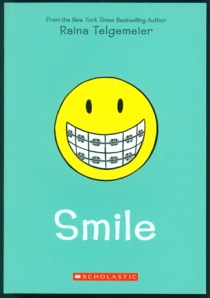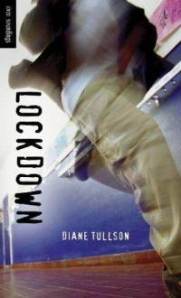Struck by Lightning
Chris Colfer
New York: Hachette Book Group Inc., 2012.
258 pages
Monthly Archives: February 2013
Smile by Raina Telgemeier
 Smile
Smile
Raina Telgemeier
New York: Graphix, 2010.
213 pages, chiefly col. ill.
Meet Raina a gawky, uncomfortable girl in grade-six, facing more than just typical puberty discomforts. While running home after Girl Guides, Raina trips, knocking out her front teeth, and simultaneously knocking down her self-confidence a few pegs. Correcting her smile takes years, numerous painful surgeries and a whole lot of comfort gained from watching The Little Mermaid and playing Nintendo.
The comic is charming and adorable. Raina’s discomfort with her appearance – while more extreme than most other ‘brace-faces’, or new glasses wearers – is very relatable. From changing schools, to having friends maturing more quickly than she is, to realizing maybe those people are not her friends, and finding her own niche, Raina’s experience reflects in some way the past experiences of most adults and the current experiences of pre-teens and teens.
For readers today, some of the references won’t be recognizable or appreciated in the way that they will be for those who were teens in the 90s and 00s. While most grade sixes are probably be familiar with The Little Mermaid, other references like old school Nintendo games, hair scrunchies, The Baby-Sitter Club books, Y.M. magazine, and New Kids on the Block, may not be as familiar. In not picking up or understanding these references, younger readers will not lose out on the relatability of the storyline, but it is an added benefit for older readers.
The illustrations are bright and clear. Every frame directly relates to the narrative, adding small details and visualizations that enhance Raina’s experiences, especially because the reader has the chance to really see just how horrible her teeth situation becomes. Raina Telgemeier’s retelling of her extreme dental situation, and less extreme experiences through middle school are very clearly portrayed, and made very relatable to the reader in this medium.
Literacies Across Media
Chapter 6: Salience and Fluency
Margaret Mackey
I wasn’t necessarily surprised by Margaret Mackey’s findings in Chapter 6: Salience and Fluency of her text Literacies Across Media. I think the fact that the children being studied were able to distinguish their interest and the potential direction of the story just by reading, watching or playing through introductions was great – but I feel like media is set up for media consumers to be able to do that. Very infrequently will the tone of any material change so quickly that a movie you initially interpret to be a romantic comedy will turn out to be a horror movie. We are trained as media consumers to pick up on things like character introductions, and retain that information because it will most likely be significant at some point, and the more practise we have the easier it is. One example from of this from the chapter, is the introduction of a clown during the first few minutes of the movie Air Bud. The children were easily able to discern that at some point the clown would become significant to the storyline. The fact that the children studied were able to pick up on these literature and thematic cues, demonstrates how these kinds of tropes become second nature to us as media consumers.
I would be interested to know how many of the children whose responses being studied were previously familiar with the materials that they were shown. Mackey does acknowledge that she would attempt to find out the first impression on a material and if the participant would pick up the material again, but how trustworthy are recollections of past impressions? I can think of numerous books that I have read where the introduction was not captivating, but after I had forced myself to read through the end, I ended up liking the material. After the first 50 pages of The Girl With The Dragon Tattoo for instance, I was ready to put the book down. But I was urged to keep reading by others who had read the books, and I was told that after page 200 the story becomes much more interesting – which was true. My impression of the introduction ultimately became secondary to my feeling of the material as a whole. As I am presumably a more seasoned reader than the children being interviewed, and my ability to separate my feelings about a materials introduction becomes skewed by my feelings of the material overall, then I do not believe children would be anymore successful in separating the two.
The chapter reinforced for me that everyone has their own preferences and reasons for their preferences that don’t necessarily change no matter what kind of media you are consuming.
Orca Soundings
 Lockdown
Lockdown
Diane Tullson
Victoria, B.C.: Orca Book Publishers, 2008.
103 pages
The Orca Soundings titles are great novels for reluctant readers, or readers who maturity level is higher than their reading ability. In Lockdown by Diane Tullson, Adam a Grade 10 student is stuck in the middle of school shooting, only to find out the shooter is a friend of his.
The story itself while dealing with a difficult topic is very simplistic. The entire narrative occurs in a non-descript high school, over the span of a single day. Adam’s first person narrative is very clear and straightforward. Only a few secondary characters are introduced and their roles are very distinctive so that they do not get confused easily. During conversations or descriptions, the person or object being spoken about is consistently reinforced so that the reader does not become confused about the subject.
Even though the title deals with a fairly difficult and violent topic, there is very little description of violence. Similarly, the psychological aspect of what lead the shooter to the kind of violent act he committed, is in no way discussed. All of the actions are described in a one forward motion, with only a little bit of allusion or discussion of previous events.
Keeping the storyline fairly simplistic is beneficial for struggling readers. But, once a reader is past the stage of needing simplistic storylines, characters and settings, these books may be found as somewhat frustrating in the way that everything is spelt out with very little need for interpretation.